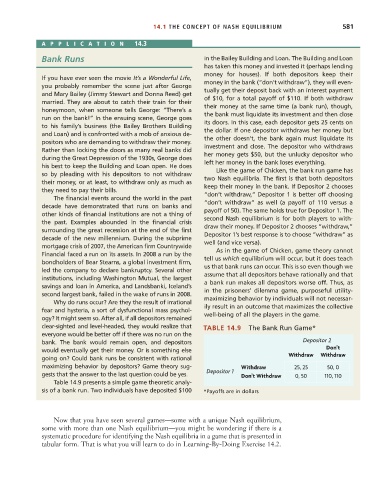Page 607 - Microeconomics, Fourth Edition
P. 607
c14gametheoryandstrategicbehavior.qxd 8/6/10 8:22 AM Page 581
14.1 THE CONCEPT OF NASH EQUILIBRIUM 581
APPLICA TION 14.3
Bank Runs in the Bailey Building and Loan. The Building and Loan
has taken this money and invested it (perhaps lending
money for houses). If both depositors keep their
If you have ever seen the movie It’s a Wonderful Life,
money in the bank (“don’t withdraw”), they will even-
you probably remember the scene just after George
tually get their deposit back with an interest payment
and Mary Bailey (Jimmy Stewart and Donna Reed) get
of $10, for a total payoff of $110. If both withdraw
married. They are about to catch their train for their
their money at the same time (a bank run), though,
honeymoon, when someone tells George: “There’s a
the bank must liquidate its investment and then close
run on the bank!” In the ensuing scene, George goes
its doors. In this case, each depositor gets 25 cents on
to his family’s business (the Bailey Brothers Building
the dollar. If one depositor withdraws her money but
and Loan) and is confronted with a mob of anxious de-
the other doesn’t, the bank again must liquidate its
positors who are demanding to withdraw their money.
investment and close. The depositor who withdraws
Rather than locking the doors as many real banks did
her money gets $50, but the unlucky depositor who
during the Great Depression of the 1930s, George does
left her money in the bank loses everything.
his best to keep the Building and Loan open. He does
Like the game of Chicken, the bank run game has
so by pleading with his depositors to not withdraw
two Nash equilibria. The first is that both depositors
their money, or at least, to withdraw only as much as
keep their money in the bank. If Depositor 2 chooses
they need to pay their bills.
“don’t withdraw,” Depositor 1 is better off choosing
The financial events around the world in the past
“don’t withdraw” as well (a payoff of 110 versus a
decade have demonstrated that runs on banks and
payoff of 50). The same holds true for Depositor 1. The
other kinds of financial institutions are not a thing of
second Nash equilibrium is for both players to with-
the past. Examples abounded in the financial crisis
draw their money. If Depositor 2 chooses “withdraw,”
surrounding the great recession at the end of the first
Depositor 1’s best response is to choose “withdraw” as
decade of the new millennium. During the subprime
well (and vice versa).
mortgage crisis of 2007, the American firm Countrywide
As in the game of Chicken, game theory cannot
Financial faced a run on its assets. In 2008 a run by the
tell us which equilibrium will occur, but it does teach
bondholders of Bear Stearns, a global investment firm,
us that bank runs can occur. This is so even though we
led the company to declare bankruptcy. Several other
assume that all depositors behave rationally and that
institutions, including Washington Mutual, the largest
a bank run makes all depositors worse off. Thus, as
savings and loan in America, and Landsbanki, Iceland’s
in the prisoners’ dilemma game, purposeful utility-
second largest bank, failed in the wake of runs in 2008.
maximizing behavior by individuals will not necessar-
Why do runs occur? Are they the result of irrational
ily result in an outcome that maximizes the collective
fear and hysteria, a sort of dysfunctional mass psychol-
well-being of all the players in the game.
ogy? It might seem so. After all, if all depositors remained
clear-sighted and level-headed, they would realize that TABLE 14.9 The Bank Run Game*
everyone would be better off if there was no run on the
bank. The bank would remain open, and depositors Depositor 2
Don’t
would eventually get their money. Or is something else
Withdraw Withdraw
going on? Could bank runs be consistent with rational
maximizing behavior by depositors? Game theory sug- Depositor 1 Withdraw 25, 25 50, 0
gests that the answer to the last question could be yes. Don’t Withdraw 0, 50 110, 110
Table 14.9 presents a simple game theoretic analy-
sis of a bank run. Two individuals have deposited $100 *Payoffs are in dollars
Now that you have seen several games—some with a unique Nash equilibrium,
some with more than one Nash equilibrium—you might be wondering if there is a
systematic procedure for identifying the Nash equilibria in a game that is presented in
tabular form. That is what you will learn to do in Learning-By-Doing Exercise 14.2.

